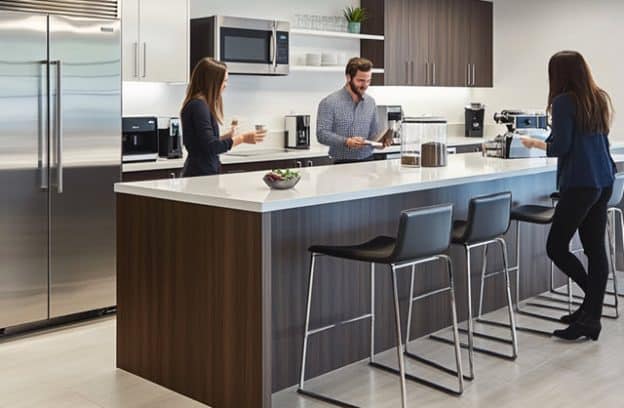When the coffee machine sputters to life at 7 AM or the refrigerator hums quietly in the corner, these moments define the heartbeat of any commercial workspace. Smart facility managers understand that appliance repair needs don’t announce themselves with convenient timing, and effective appliance repair strategies become essential for maintaining the seamless operations that keep employees energized and focused throughout their busy workdays.
The modern break room has evolved far beyond the stereotypical space with a lonely vending machine and flickering fluorescent lights. Today’s workplace kitchens serve as productivity powerhouses where teams recharge, collaborate, and build the relationships that drive business success. Finding reliable appliance repair services becomes crucial when these spaces support dozens or hundreds of employees daily. Research from Harvard Business Review confirms that positive work environments directly correlate with increased productivity, making break room functionality a strategic business investment.
The Psychology of Appliance Reliability in Workplace Culture
Think of break room appliances as the supporting actors in your office’s daily drama. When they perform flawlessly, nobody notices them, but when they fail, they steal the show in all the wrong ways. That grinding sound from the ice maker becomes the soundtrack to workplace frustration, while a temperamental microwave transforms quick lunch breaks into extended troubleshooting sessions.
The ripple effects extend far beyond simple inconvenience. Employees who can’t rely on basic amenities start bringing their own coffee makers, mini-fridges, and heating devices to their desks. This seemingly harmless workaround creates electrical load issues, cluttered workspaces, and the very real possibility of tripped breakers during critical business operations.
Smart office managers recognize that appliance reliability directly impacts employee satisfaction scores and retention rates. When the coffee flows consistently and the refrigerator maintains perfect temperatures, these small victories contribute to the positive workplace culture that attracts top talent and keeps valuable team members engaged.
Creating a Maintenance Rhythm That Actually Works
Commercial break room appliances face challenges that would make residential units weep. They operate continuously throughout extended business hours, serve vastly more users than intended, and endure the kind of heavy usage that tests even the most robust engineering. The key lies in developing maintenance schedules that anticipate problems rather than react to failures.
Start with usage pattern analysis that reveals when your appliances work hardest. Monday mornings create coffee machine overload as everyone jumpstarts their week. Friday afternoons see refrigerator overcrowding as employees stock up for weekend meal prep. Understanding these patterns enables proactive maintenance scheduling during lower-demand periods.
Document everything with the precision of a medical chart. When did the coffee maker last receive descaling? How often does the refrigerator’s temperature fluctuate? Which microwave gets the heaviest use? This data transforms vague maintenance hunches into actionable intelligence that prevents costly emergency repairs.
The Coffee Station: Mission Control for Morning Productivity
Coffee equipment deserves special attention because it directly impacts how quickly your team reaches peak performance each day. A sluggish espresso machine doesn’t just slow down individual coffee preparation; it creates bottlenecks that delay meetings, interrupt focus time, and generally cascade through the entire organization’s momentum.
Descaling schedules must account for water quality in your specific location because hard water accelerates mineral buildup that clogs internal components. Install water filtration systems that protect your investment while improving taste quality. Employees notice when their morning coffee tastes better, and this small detail contributes to overall workplace satisfaction.
Consider the ergonomics of coffee station placement within your break room layout. Equipment positioned too close to high-traffic areas creates congestion during peak usage times. Strategic placement allows multiple employees to access different appliances simultaneously without creating human traffic jams.
Refrigeration: The Silent Workhorses of Workplace Satisfaction
Commercial break room refrigerators work overtime compared to their residential cousins, opening and closing hundreds of times daily while maintaining consistent temperatures despite constant door access. This demanding environment requires maintenance approaches that address both mechanical stress and hygiene concerns.
Temperature monitoring systems provide early warning when cooling efficiency begins declining. Modern smart sensors can alert facility managers to temperature fluctuations before spoiled food creates unpleasant odors or health concerns. These proactive notifications enable repairs during convenient times rather than emergency situations.
Establish clear protocols for employee refrigerator use that reduce mechanical stress while maintaining cleanliness standards. Label areas for different types of food storage, implement regular cleaning schedules, and provide guidance about appropriate container sizes that don’t block air circulation vents.
Microwave Mastery: Handling High-Volume Heating Demands
Break room microwaves endure punishment that would destroy typical home units within months. Splattered food, overheated containers, and continuous operation create maintenance challenges that require specialized attention. The goal involves extending equipment lifespan while ensuring consistent heating performance.
Interior cleaning schedules must address both hygiene and operational efficiency concerns. Food residue creates hot spots that damage internal components while generating unpleasant odors that affect the entire break room environment. Weekly deep cleaning prevents buildup that leads to expensive repairs or premature replacement needs.
Ventilation system maintenance often gets overlooked but directly impacts microwave performance and longevity. Blocked exhaust fans cause overheating that damages internal electronics while creating uncomfortable humidity levels in surrounding areas. Regular filter replacement and fan cleaning protect your investment while maintaining pleasant break room conditions.
Small Appliances with Big Impact on Daily Operations
Seemingly minor appliances like toasters, blenders, and single-serve coffee makers contribute significantly to break room functionality and employee satisfaction. These devices face unique maintenance challenges because employees often use them incorrectly or push them beyond intended capabilities.
Create usage guidelines that protect equipment while maximizing utility. Post simple instructions near appliances that explain proper operation, capacity limits, and basic troubleshooting steps. This proactive approach prevents abuse while empowering employees to resolve minor issues independently.
Establish rotation schedules for appliances that receive heavy use. Having backup units available enables continued service during maintenance periods while extending the primary equipment’s operational lifespan. This redundancy prevents break room shutdowns that force employees to seek alternatives outside the office.
Preventive Maintenance Scheduling for Maximum Uptime
Smart maintenance scheduling balances thorough care with minimal disruption to daily operations. Unlike residential settings where appliance downtime creates minor inconveniences, commercial break room equipment failures can affect dozens of employees simultaneously and impact overall productivity.
Develop maintenance windows during low-usage periods like early mornings, late afternoons, or weekends when fewer employees depend on break room facilities. Communicate these schedules clearly so teams can plan accordingly and avoid frustration when equipment becomes temporarily unavailable.
Create maintenance checklists that capture both routine care tasks and deeper inspection items. Daily cleaning and safety checks catch obvious problems early, while weekly and monthly procedures address mechanical components that require more thorough attention. This layered approach prevents both minor annoyances and major failures.
Building Relationships with Service Providers Who Understand Commercial Needs
Commercial appliance repair requires specialized expertise that differs significantly from residential service approaches. Commercial equipment operates under more demanding conditions, requires different replacement parts, and needs faster response times to minimize business impact.
Establish relationships with service providers before problems arise rather than scrambling for help during emergencies. Quality commercial appliance repair services understand business environments and can prioritize urgent requests appropriately. They also stock parts for common commercial appliances, enabling faster repairs.
Negotiate service agreements that align with your business needs rather than accepting standard residential service terms. Commercial operations require faster response times, flexible scheduling options, and clear communication about repair timelines that affect employee services.
Technology Integration for Modern Break Room Management
Smart appliance monitoring systems transform reactive maintenance into proactive management by providing real-time performance data and predictive failure warnings. These technologies enable facility managers to address issues before they impact employee services.
Consider appliances with built-in diagnostic capabilities that can communicate directly with building management systems. When the coffee maker detects internal scale buildup or the refrigerator identifies cooling efficiency decline, automatic alerts enable timely maintenance scheduling.
Implement inventory management systems that track usage patterns and predict supply needs. Understanding which coffee pods, water filters, and cleaning supplies get consumed fastest enables better procurement planning while ensuring break room amenities remain consistently available.
Cost-Effective Strategies for Long-Term Equipment Management
Break room appliance investments should be evaluated through total cost of ownership calculations rather than initial purchase prices alone. Higher-quality commercial-grade equipment often delivers better long-term value through improved reliability, lower maintenance costs, and longer operational lifespans.
Energy efficiency considerations become more significant in commercial settings where appliances operate continuously throughout extended business hours. Modern energy-efficient models can reduce operational costs significantly while contributing to corporate sustainability goals.
Plan replacement schedules based on usage data and maintenance history rather than arbitrary timelines. Some appliances in low-usage break rooms may last significantly longer than average, while high-traffic equipment might require earlier replacement to maintain reliability standards.
Your break room appliances represent far more than simple conveniences; they form the infrastructure that supports your team’s daily energy and collaboration needs. When coffee flows reliably, food stays fresh, and heating happens quickly, these foundational elements enable employees to focus on the work that drives your business forward. Strategic maintenance approaches protect these investments while ensuring the consistent functionality that makes great workplace culture possible.
Through proactive care, smart scheduling, and quality service relationships, facility managers can transform break room maintenance from a reactive expense into a strategic advantage that enhances employee satisfaction and supports organizational productivity goals.


